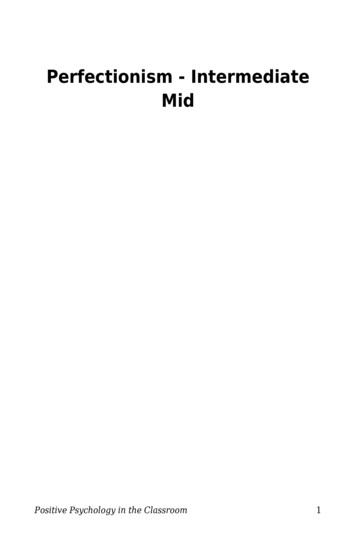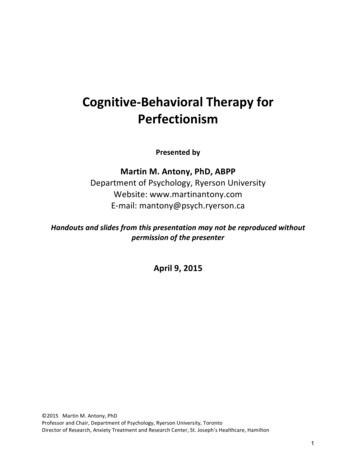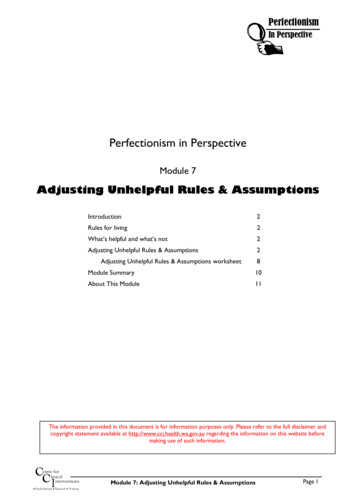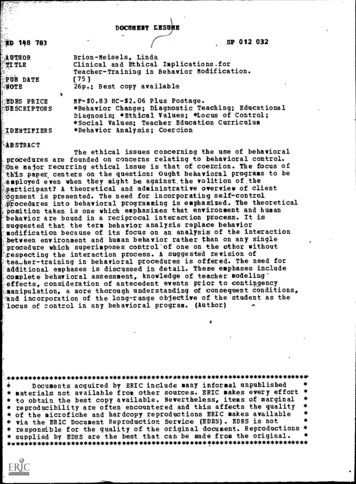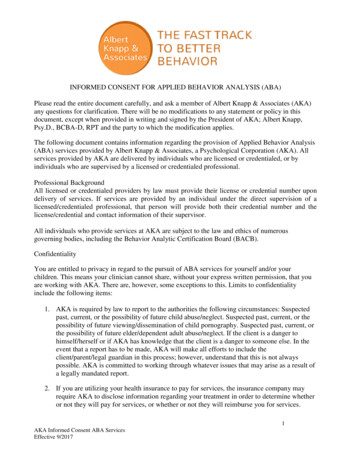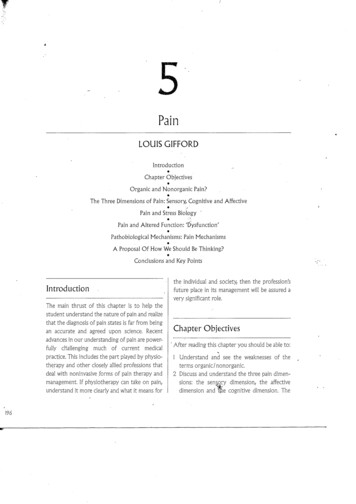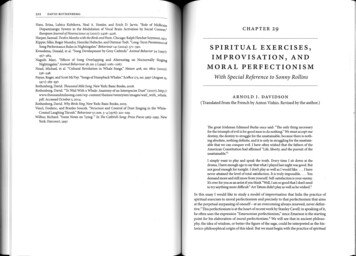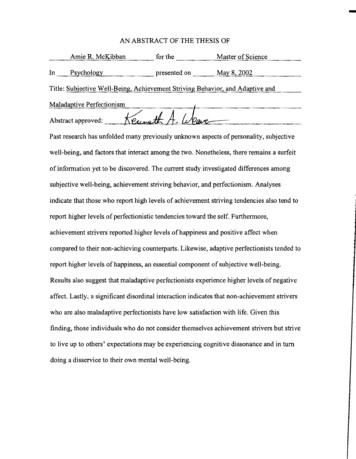
Transcription
AN ABSTRACT OF THE THESIS OFInArnie R. McKibbanfor theMaster of SciencePsychologypresented onMay 8, 2002Title: Subjective Well-Being, Achievement Striving Behavior, and Adaptive andMaladaptive PerfectionismAbstract approved:1/d! A A;JI Past research has unfolded many previously unknown aspects of personality, subjectivewell-being, and factors that interact among the two. Nonetheless, there remains a surfeitof information yet to be discovered. The current study investigated differences amongsubjective well-being, achievement striving behavior, and perfectionism. Analysesindicate that those who report high levels of achievement striving tendencies also tend toreport higher levels of perfectionistic tendencies toward the self. Furthermore,achievement strivers reported higher levels of happiness and positive affect whencompared to their non-achieving counterparts. Likewise, adaptive perfectionists tended toreport higher levels of happiness, an essential component of subjective well-being.Results also suggest that maladaptive perfectionists experience higher levels of negativeaffect. Lastly, a significant disordinal interaction indicates that non-achievement striverswho are also maladaptive perfectionists have low satisfaction with life. Given thisfinding, those individuals who do not consider themselves achievement strivers but striveto live up to others' expectations may be experiencing cognitive dissonance and in tumdoing a disservice to their own mental well-being.
SUBJECTIVE WELL-BEING, ACHIEVEMENT STRIVINGBEHAVIOR, AND ADAPTIVE AND MALADAPTIVE PERFECTIONISMA ThesisPresented toThe Department of Psychology and Special EducationEMPORIA STATE UNIVERSITYIn Partial FulfillmentOf the Requirements for the DegreeMaster of SciencebyArnie R. McKibbanMay 2002
IIht.,"\UA Approved for the Department ofPsychology and Special EducationIJii
ACKNOWLEDGEMENTSSincere appreciation to Dr. Kenneth Weaver for reviewing my numerous drafts ofthis thesis and for continually challenging me to better my research abilities. Thanks toDr. Cooper Holmes and Dr. Cathy Grover for having the patience and desire to readthrough my tremendously long drafts. A note of appreciation is expressed to Dr. StephenDavis for acknowledging in me the ability to conduct research while I was anundergraduate student struggling to make sense ofthis area. Lastly, sincere thanks to myfamily for supporting and encouraging me throughout my many academic endeavors.tfI1i.1III
TABLE OF CONTENTSAKNOWLEDGEMENTS.iiiTABLE OF CONTENTS.ivLIST OF TABLESviCHAPTER1 INTRODUCTION1Subjective Well-Being1Type A Behavior Pattern4History of the Type A Behavior Pattern.4Achievement Striving Component.8Perfectionism10Literature Review Summary and Hypotheses122METHOD16Participants16Experimental Design16External Validity16Instrumentation17Consent Form17Demographic Questionnaire17Achievement Striving Scale17Multidimensional Perfectionism Scale18Subjective Well-Being InstrumentationFordyce Happiness Measureiv1919
Satisfaction with Life Scale21Positive and Negative Affect Schedules22Procedure223 RESULTS24Correlation for Hypothesis 124ANOVA for Satisfaction with Life26ANOVA for Fordyce Happiness Measure26ANOVA for Positive and Negative Affect304 DISCUSSION31Hypothesis 132Hypothesis 233Hypothesis 3 and 434Implications36Limitations and Future Research36REFERENCES38APPENDICES44Appendix A: Informed Consent Document.44Appendix B: Demographic Questionnaire.45v
LIST OF TABLESTABLE1PAGECorrelations Between Achievement Striving and PerfectionismMeasures225Summary of Means and Standard Deviations ofSWLS for AchievementStriving and Perfectionism327Summary of Means and Standard Deviations ofHM for AchievementStriving and Perfectionism428Summary of Means and Standard Deviations ofPA for AchievementStriving and Perfectionism529Summary of Means and Standard Deviations ofNA for AchievementStriving and Perfectionism31vi
1CHAPTER 1INTRODUCTIONFor years, philosophers, scientists, and the general public have been intrigued bythe notion of happiness. From Aristotle to Dr. Laura, speculations about happiness arecopious. Articles saturate popular magazines claiming to hold the key to a happylifestyle. Movies, commercials, and local programming depict many individuals living afruitful and prosperous life, with the characters content and exultant. Likewise, scientificstudies investigating happiness frequently appear in psychological journals. Nonetheless,the question "Who is happy?" continues to captivate many individuals.As depicted in popular media, happy individuals appear to live successful andproductive lives. Some would argue that setting goals, working toward those goals, andstriving for excellence attaining those goals are characteristic of happiness. Although thisappears to be the widespread belief among contemporary society, the components ofhappiness still remain to be fully identified by science. Consequentially, the currentinvestigation begins with a review ofthe literature on subjective well-being (whichincludes happiness), achievement striving behavior as a component ofthe Type ABehavior Pattern, and perfectionism.Review of the LiteratureSubjective Well-BeingSubjective well-being (SWB) focuses primarily on why and how peopleexperience their lives in positive ways (Diener, 1984). Subjective well-being consists oftwo broad aspects: An affective component of positive affect (pA) and negative affect(NA), and a cognitive component referred to as life satisfaction (Pavot & Diener, 1993).
2Positive affect refers to the degree to which a person feels "enthusiastic, active, andalert," whereas NA refers to a "general dimension of subjective distress andunpleasurable engagements that subsumes a variety of aversive mood states" (Watson,Clark, & Tellegen, 1988, p. 1063). Moreover, life satisfaction is an integrated, globaljudgment of a person's quality oflife based on comparing personal standards withperceived life circumstances, therefore making life satisfaction a "conscious cognitivejudgment" (Pavot & Diener, 1993, p. 164). Furthermore, Diener (1984) reportedhappiness as being the influence of positive affect over negative affect with attention onthe emotional evaluation of one's situation in life (i.e., an overall affective appraisal).Understanding why and how some people experience subjective well-being andlife satisfaction at higher levels than others is an ongoing task. Fordyce (1983) developedthe "14 fundamentals of happiness" such as "(a) keep busy and be more active; (b) getbetter organized and plan things out; (c) be productive at meaningful work; and (d)develop positive, optimistic thinking" (p. 484). Furthermore, Csikszentimihalyi (1999)stated that understanding happiness comes from knowing one's quality of work andleisure experiences. Csikszentimihalyi (1990) also contended, through his research on theconcept of "flow," that elevated positive moods more frequently occurred whenparticipants were involved in challenging tasks rather than enjoying leisure time, withchallenging tasks being a common characteristic of achievement strivers.If a person's activity level influences positive affect (e.g., Bradburn, 1969), theremight be evidence relating achievement striving, happiness, and SWB. Burke and Weir(1980) reported that persons with greater Type A behaviors experience less depressionand greater life satisfaction. In addition, Bluen, Barling, and Bums (1990) suggested the
3achievement striving component of the Type A behavior pattern is unrelated todepression. However, given that no relationship was found, it cannot be inferred thatachievement striving individuals experience less or no depression when compared to theircounterparts.If ''work-oriented achievement strivings.remain significantly related to students'high academic performance" (Spence, Pred, & Helmreich, 1989, p. 176), then personswho exhibit AS behaviors possess the tendency to be goal directed, as seen in highacademic achievement. Emmons and Diener (1985) found that setting goals and workingto achieve those goals were predictors ofSWB. Moreover, DeNeve and Cooper's (1998)meta-analysis revealed that conscientiousness, which includes goal directed behavior,"obtained the strongest positive association with life satisfaction" (p. 220).McKibban and Nelson (2001) predicted positive correlations between happinessand life structure (Le., the amount to which one is dedicated to a routine daily schedule)and happiness and achievement striving. In their study, 86 undergraduate studentvolunteers (18 men and 68 women) completed the achievement striving subscale of therevised student version of the Jenkins Activity Scale (JAS; Spence, Helmreich, & Pred1987) and four measures of happiness (Fordyce Happiness Measure, Satisfaction withLife Scale, and the Positive and Negative Affect Scales). All three happiness scales weresignificantly, positively correlated with the JAS (rs 0.44, 0.32, and 0.59, respectively).Additionally, life structure and positive affect were also positively related. These resultssuggest that achievement striving persons who perceive their life as structured reportgreater levels of happiness and subjective well-being.
4Type A Behavior PatternPike (as cited in Larose, 1999) once said "life is not measured in hours but inaccomplishments." Possessing a need for achievement dictates a desire to do well and todemonstrate personal competence (Reeve, 1997). Consequently, accomplishment denotesachievement. Achievement motivation research encompasses Type A behavior, whichincludes two subsets: achievement striving and impatience and irritability (Barling &Charbonneau, 1992; Spence et aI., 1987; Spence et aI., 1989).History ofthe Type A Behavior Pattern. Type A behavior pattern (TABP) is not apersonality trait but a combination of explicit behaviors elicited by a challengingenvironment. TABP is a set of behaviors ranging from extreme Type A behavior toextreme Type B behavior (i.e., individuals who do not exhibit any behaviors that arecharacteristic of Type A individuals) rather than a typology. In this formulation, Type Aindividuals possess: (1) an intense desire to attain self-selected but poorly defined goals;(2) an eagerness to compete; (3) a longing for acknowledgment and advancement; (4) acontinuous involvement in multiple tasks subject to stringent time restrictions; (5) achronic inclination to accelerate the rate of completion of most mental and physical tasks;(6) astounding alertness; (7) achievement orientation; and (8) aggressive and hostileemotions (Matthews, 1982; Rosenman, Swan, & Carmelli, 1988). Accordingly,Rosenman et aI. (1988) defined TABP "as an action-emotion complex involvingbehavioral dispositions (e.g., ambitiousness, competitiveness), specific behaviors (e.g.,muscle tension, alertness), and emotional responses (e.g., irritation, hostility)" (p. 9).TABP is composed of three separate dimensions: job involvement,competitiveness, and impatience (e.g., Matthews, Glass, Rosenman, & Bortner, 1977).
5Three potential determinants of the relationship between the latter dimensions and theTABP have been suggested by prior research: (1) feelings of self-efficacy, which is thepersonal judgment of how well one can accomplish a task at hand; (2) performancestandards and goals; and (3) an inclination to work on more than one project at a time(Taylor, Locke, Lee, & Gist, 1984). The study ofTABP primarily focuses onperformance-based behavior. One such study investigated the relation between Type Abehavior and research productivity of university faculty (Taylor et aI., 1984). Universityfaculty (N 278) completed the Individual Behavior Activity Profile (TABP measure)and a questionnaire containing items that targeted self-efficacy; the extent to whichparticipants become involved with multiple projects; the extent to which participants setausterely acceptable goals in regards to publications, rank and salary; and actual quantityof publications. They found a significant positive correlation (p .01 in all cases)between Type A behavior and (a) self-efficacy (r .18), (b) number of simultaneousprojects (r .23), (c) number of performance goals (r .22), and (d) number of facultypublication citations (r .25). Volkmer and Feather (1991) also report Type Aindividuals who are strong in achievement striving tendencies are more likely to have anintemallocus of control, stating that individuals who report high levels of Type Abehavior tend to "perform better at work, both with respect to quantity and quality ofperformance" (p. 412). They also experience "rapid career advancement, are moreeducated, attain a higher occupational status" (Matthews, 1982, p. 302), and attain morerewards from work (Matthews, Helmreich, Beane, & Lucker, 1980).TABP includes countering probable failure on a performance task with persistenteffort to succeed, even if it requires a slower work rate. Concisely, individuals who
6exhibit TABP insist on and appear to have greater success in school and work (Glass,1977; Matthews et al., 1980). Individuals who exhibit TABP focus their attention,disregarding distractions that might lower task effort and performance (Matthews &Brunson, 1979). Type A students spend more time studying and tend to work for paidemployment rather than volunteering (Glass, 1977). They also report being more active inextracurricular events, maintaining leadership positions, and receiving more academichonors than Type B college students. TABP individuals thrive on the need for successand will work accordingly to achieve it.Given that Type As tend to work hard, remain persistent, and maintain controlover their environment (Furnham, Hillard, & Brewin, 1985), do they outperform Type Bindividuals? Matthews (1982) reported that Type As tend to outperform Type Bs indifficult tasks requiring persistence and endurance. However, Type Bs do better when thetask calls for unhurried, meticulous responses (Glass, Snyder, & Hollis as cited inMatthews, 1982), a general focus of attention (Matthews & Brunson, 1979), orunremitting performance after extended salient failure (Brunson & Matthews, 1981).When the failure is not highly salient (i.e., not significant or prominent), Type Asoutperform Type Bs (Brunson & Matthews, 1981; Krantz, Glass, & Snyder, 1974). Thus,Type As might not continue to outperform Type Bs in tasks requiring persistence andendurance when failure is salient. In support of this not-so-optimistic prediction forcompetitive achievement-striving behavior, Perry, Kane, Bemesser, and Spieker (1990)concluded that when Type A students are "in situations in which their expectancies forsuccess cannot be reached by exerting additional effort, they will use other means,"precisely, cheating (p. 463). Accordingly, Weiss, Gilbert, Giordano, and Davis (1993)
7suggested students who score high on measures of Type A behavior appear to be morepreoccupied with the consequences of achievement rather than the means of achievement.This last finding might lend support for the notion that Type A individuals thrive on theneed for success, therefore working accordingly to achieve it and employing proceduresto avoid failure.If Type As set significantly higher performance standards and goals on tasks(Grimm & Yarnold, 1984; Ovcharchyn, Johnson, & Petzel, 1981), constructiveconsequences should arise if these standards and goals lead to actual greater performancelevels, but would maladaptive consequences for Type As result from failure to achieve?Friedman and Ulmer (as cited in Ward & Eisler, 1987) proposed that failure to attainperformance goals could result in inadequate self-esteem, which may be the basis forType A achievement striving. Ward and Eisler (1987) tested this relationship by askingType A and Type B participants to establish performance goals for two generalinformation tests and for the combined test. In advance of completing the tests,participants were informed that the scores predicted intelligence and academic success.After completing the test, participants received feedback on their performance scores.Type As were less likely to achieve their performance goals for both the combined scoresand each individual test. Furthermore, Type As set significantly higher goals, performedno differently, and obtained a greater achievement discrepancy for both tests whencompared to their Type B counterparts. This pattern of results suggests that Type As fallshort of achieving their personal performance goals because they are inclined to set goalsbeyond their capabilities. The latter results support Friedman and Ulmer'saforementioned proposal that Type A achievement striving tends to be characterized by
8failure to attain elevated performance goals or standards, because the goals are in factelevated too high. This study also corroborates previous findings that Type Aachievement striving is positively related to measures of achievement influenced byeffort (e.g., Work and Family Orientation Scale, grade point average) rather thanmeasures influenced by ability (e.g., Scholastic Aptitude Test). In addition, Feather andVolkmer (1991) investigated the relationship between task preference and theachievement striving component of the TABP. Participants who scored high onachievement striving behavior (as indicated by the modified student version of the JAS)tended to prefer more difficult tasks that involve effort. These results insinuate that TypeA individuals "actively seek out situations that match their personalities" (p. 26).Achievement Striving Component. Achievement striving tendencies are distinctand noticeable in TABP. Spence et al. (1987, 1989) first reported TABP as measured bythe JAS actually consisted of two distinct components, Achievement Striving (AS) andImpatience and Irritability (III), which could operate independently of each other ratherthan concomitantly. Their work was later corroborated by Barling and Charbonneau(1992). Spence et al. (1987) conducted a factor-analytic study involving college studentson the JAS (Jenkins, Zyzanski, & Rosenman, 1971). III scores were positively related(p .05) to number of self-reports of incidence of illness for both men (r .31) andwomen (r .18) but were unrelated to their GP A. Conversely, students' GPAs werepositively associated (p .05) with scores on the AS factor scale (e.g., hard working,active) for both men (r .36) and women (r .33) but unrelated to the illness self reports. Two years after these findings were published, Spence et al. (1989) reported that"the kind of work-oriented achievement strivings measured by the AS scale.remains
9related to students' academic performance over a period spanning two or more years oftheir undergraduate careers" (p. 177). These findings support the notion that AS scorescan predict future academic performance during students' undergraduate degree. Asmentioned previously, Barling and Charbonneau (1992) substantiated the latter findingsby providing data to support the claim that AS behavior, in relation to the TABP, ispositively related to students' grades and also proofreading performance. Aftercompleting a modified version ofthe JAS, Barling and Charbonneau had students readfour double-spaced typed pages that consisted of 103 errors. Students were asked tounderline, without correcting, as many errors as they could find within five minutes. Thenumber of errors underlined was used as the criterion variable. This proofreading taskmeasured performance quality, given the "number of errors found reflects concentrationand attention during the five minute period" (p. 373). AS is significantly correlated withGPA (r 0.32, p .01) and proof-reading (r 0.17, p .05). AS (measured by themodified version of the JAS by Spence et aI., 1987) is also correlated with the quantityand quality of research productivity (Helmreich, Spence, & Pred, 1988; Matthews et aI.,1980; Taylor et aI., 1984), the number of insurance policies sold and job satisfaction(Bluen et aI., 1990), and academic performance and decreases in performancedysfunction (Lee, Jamieson, & Earley, 1996).PerfectionismGiven that individuals who score high on Type A behavior tend to be driven bythe desire for success and will work accordingly to achieve it, and that those whospecifically score high on the AS aspect of the TABP tend to have high academic andcareer success (both in quantity and quality), a reasonable inference is that AS and
10perfectionism are positively related. Several research studies have investigatedperfectionism (e.g., Frost, Heimberg, Holt, Mattia, & Neubauer, 1993; Hamachek, 1978;Lynd-Stevenson & Hearne, 1999; Terry-Short, Owens, Slade, & Dewey, 1995). Earlystudies of perfectionism proposed numerous definitions of the construct, primarilybecause this construct was related to various psychopathologies (Terry-Short et aI.,1995). Nevertheless, the unidimensional, self-directed notions of perfectionism have beenreplaced by multidimensional models (e.g., Hewitt & Flett, 1991; Hamachek, 1978).At present, perfectionism appears to be a multidimensional personality variable,with two different facets that emerge, namely maladaptive and adaptive. "Neurotic" (i.e.,maladaptive) perfectionists set unrealistic expectations and are never satisfied with theirwork (Hamachek, 1978). A person with "normal" (i.e., adaptive) perfectionism thrivesfor excellence but is tolerant and accepts individual limitations. Adkins and Parker (1996)described maladaptive perfectionism in terms of "passive" perfectionists who secondguess their decisions, have a fear of making mistakes, and procrastinate. In contrast,adaptive or "active" perfectionism describes those for whom perfectionistic strivingsstimulate and impel them to engage in achievement related strivings. Terry-Short et al.(1995) differentiated between maladaptive and adaptive perfectionism in terms of"negative" perfectionism in which individuals avoid aversive consequences and"positive" perfectionism in which individuals achieve to gain positive consequences.Although the latter studies give different categorical labels to the two dimensions thathave been shown to emerge from the perfectionism construct, they all have the sameunderlying tone; one dimension is adaptive and the other maladaptive, with maladaptiveperfectionism predisposing individuals to depression (Adkins & Parker, 1996;
11Hamachek, 1978; Lynd-Stevenson & Hearne, 1999). More specifically, maladaptiveperfectionists insist on a higher level of performance from themselves than is usuallypossible to attain, hence severely reducing the possibility of feeling good aboutthemselves (Hamachek, 1978).Recent researchers have defined adaptive and maladaptive perfectionism in moredirective terms. Flett, Hewitt, Blankstein, and Dynn (1994) proposed a dichotomy ofmaladaptive perfectionism: self-oriented perfectionism (perfectionistic tendenciesdirected toward the self) and socially-prescribed perfectionism (apprehension with livingup to the expectations of others and the view that others are too insistent). Self-orientedperfectionism is commonly referred to as maladaptive perfectionism, that is self-orientedindividuals tend to set unrealistic goals for themselves and to focus on failures andlimitations with great self-scrutiny. Socially-prescribed has also been referred to asmaladaptive perfectionism; specifically, social perfectionists tend to strive to meetexpectations of others despite the feeling that others are too insistent (Hewitt & Flett,1991). As measured by the Multidimensional Perfectionism Scale (Hewitt & Flett, 1991),Flett et al. (1994) reported that self-oriented and socially-prescribed perfectionismsignificantly correlated with both Achievement Striving (AS; r .36) and Impatience andIrritability (1/1; r .18). Correspondingly, Hill, McIntire, and Bacharach (1997) found anassociation between the Big Five factor of neuroticism (specifically, the anger-hostilitysub-factor included in measures of 1/1) and self (r .14) and socially-prescribed (r .24)perfectionism. In addition, they found self-oriented perfectionism to have a strongachievement striving component (r .65), a subscale of the Big Five factor ofconscientiousness, including characteristics such as setting high personal standards and a
12need to excel. These characteristics also describe AS and tend to overlapconscientiousness. Conscientious people are dutiful, ordered, and goal-directed (DeNeve& Cooper, 1998; Hill et aI., 1997). Although self-oriented perfectionism is stronglyrelated to maladaptive perfectionism, conscientiousness "help[s] document some of theadaptive features of self-oriented perfectionism related to constructive striving andresourcefulness" (Hill et aI., 1997, p. 267). It is noteworthy that Hill et al. (1997) reporteda relationship (r .59) between conscientiousness and self-oriented perfectionism. Ifcertain dimensions of perfectionism (e.g., dissatisfaction with performance and failure toachieve personal standards) predispose individuals to depression (Adkins & Parker, 1996;Hamachek, 1978; Lynd-Stevenson & Hearne, 1999), and perfectionists tend to beachievement strivers, then what factors constitute whether or not achievement striversexperience subjective well-being or depression?Literature Review Summary and HypothesesThe scientific study of subjective well-being (SWB) and happiness is relativelynew; however, speculations about these concepts are decades old. For example, thequality of one's work and the frequency of involvement in challenging tasks appear togreatly influence one's level of subjective well-being. Although much of the researchwithin the last decade has primarily focused on aspects of life, aspects of personality mayalso affect one's level of subjective well-being. Consequentially, researchers are shiftingtheir focus to the relationship between personality and subjective well-being.Another research trend over the last several decades has been to focus on thenegative, rather than positive, characteristics of human behavior. Paradoxically, examplesof characteristics having potentially detrimental effects on human behavior are
13achievement striving (i.e., setting numerous goals and working toward accomplishingthem) and perfectionism (i.e., striving for excellence), which many would associate withsuccess, accomplishment, and subjective well-being. Hence, the paradox raises the needto clarify the relationship by investigating subjective well-being in those who continuallystrive for achievement and excellence.Studying individuals who continually strive for achievement has recently led tosome possible connections between achievement striving and perfectionism. Forexample, those who actively strive for achievement tend to aspire to academic and careersuccess and prefer challenging tasks. In addition, perfectionists tend to strive forexcellence and are impelled to achieve in order to gain positive consequences. Hence,achievement strivers may also tend to be perfectionists. Despite similarities betweenthese two characteristics, support for a relationship is scant.Furthermore, if achievement strivers tend to experience more academic and careersuccess and involve themselves in tasks that require effort, then those who strive forachievement might also experience higher levels of subjective well-being. In addition, ifachievement strivers tend to be perfectionists, it might be possible that they experiencehigher levels of subjective well-being. Once again, the research investigating thispossible connection is sparse. Clearly, past research has unfolded many unknown aspectsof personality, subjective well-being, and factors that interact between the two.Nonetheless, there remains a surfeit of information yet to be discovered. The scantamount of research within the areas of human behavior discussed above provides a senseof importance in continued efforts to investigate such areas.
14As evident in this literature review, many possible relationships exist amongSWB, achievement striving, and perfectionism. If achievement striving individualsdemonstrate a tendency to set high performance goals, prefer to partake in tasks thatrequire effort, and aspire to academic and career success, and if adaptive perfectioniststend to thrive for excellence and are impelled to achieve in order to gain positiveconsequences, then Hypothesis 1 is achievement striving individuals also tend to beadaptive perfectionists.Furthermore, if achievement strivers tend to experience more academic and careersuccess and involve themselves in tasks that require effort, and if SWB depends onknowing one's quality of work and frequency of involvement in challenging tasks, thenHypothesis 2 is achievement strivers relative to non-achievement strivers should reporthigher levels of SWB. Hypothesis 3 is adaptive relative to maladaptive perfectionists willreport higher levels of SWB, given achievement strivers tend to be perfectionists and alsotend to report higher levels of SWB.Consequently, perfectionism contains a maladaptive component. If achievementstriving is related to maladaptive perfectionism and if maladaptive perfectionismpredisposes individuals to depression, then Hypothesis 4 is that maladaptive in contrast toadaptive perfectionists should experience lower levels of SWB and higher levels ofnegative affect. Mongrain and Zuroff (1995) supported this prediction by reporting thatpersons who are self-critical report lower levels of positive affect. Maladaptiveperfectionists tend to be self-critical, continually doubting their ability and second guessing their decisions (Adkins & Parker, 1996; Hamachek, 1978). Ifachievementstrivers tend to also be perfectionists, does the specific component of their perfectionistic
15tendencies (i.e., maladaptive or adaptive) determine their level ofSWB? Wong andCsikszentmihalyi (1991) stated that it is important to "consider several personalitycharacte
Correlation for Hypothesis 1 24 ANOVA for Satisfaction with Life 26 ANOVA for Fordyce Happiness Measure 26 ANOVA for Positive and Negative Affect 30 4 DISCUSSION 31 Hypothesis 1 32 Hypothesis 2 33 Hypothesis 3 and 4 34 Implications 36 Limitations and Future Research 36 REFERENCES 38 APPENDICES 44 Appendix A: Informed Consent Document . 44
